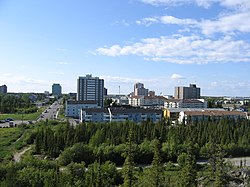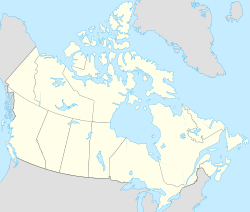耶洛奈夫
加拿大西北地區的首府
(重定向自黄刀市)
耶洛奈夫(英语:Yellowknife),也译作黄刀镇、黄刀市,是加拿大西北地区的首府。根据2021年加拿大人口普查,该市人口有大概20,000人,差不多占了整个西北地区一半的人口。[1][2]
| 耶洛奈夫 Yellowknife | |
|---|---|
| 首府 | |
| City of Yellowknife | |
 耶洛奈夫一景 | |
| 绰号:"YK"、"The Knife" | |
| 格言:Multum In Parvo(拉丁文) | |
| 坐标:62°26′32″N 114°23′51″W / 62.44222°N 114.39750°W | |
| 国家 | |
| 地区 | |
| 分区 | 北斯拉维专区 |
| 建立 | 1934年 |
| 城市地位 | 1970年1月1日 |
| 政府 | |
| • 市长 | Mark Heyck |
| • 国会议员 | Michael McLeod |
| 面积 | |
| • 首府 | 134.15 平方公里(51.80 平方英里) |
| • 陆地 | 103.37 平方公里(39.91 平方英里) |
| • 水域 | 30.78 平方公里(11.88 平方英里) |
| • 市区 | 18.11 平方公里(6.99 平方英里) |
| 海拔 | 206 米(676 英尺) |
| 人口(2021年) | |
| • 首府 | 20,340人 |
| • 密度 | 152人/平方公里(393人/平方英里) |
| • 市区 | 19,673 |
| 居民称谓 | Yellowknifer |
| 时区 | MST(UTC-7) |
| • 夏时制 | MDT(UTC-6) |
| 邮政号码 | X1A |
| 电话区号 | +1 867 |
| 电信交换 | 444 445 446 669 765 766 767 873 920 999 |
| 网站 | www |
地理
编辑耶洛奈夫位处北极圈以南约400公里,大奴湖畔。湖的外围还围着许多湖。耶洛奈夫位在北纬62.5度,被北极光椭圆环带覆盖,加上地势平坦,没有山脉阻隔,极容易见到极光。
气候
编辑耶洛奈夫基本上属亚寒带气候,全年的降雨量少于300 mm(12英寸),主因是受到西边的山脉所影响。冬天气温可达摄氏零下几十度,但夏季气温则最高曾达32.6 °C(90.7 °F)。
| 黄刀机场(1981-2010年平均数据,1942年至今极端数据) | |||||||||||||
|---|---|---|---|---|---|---|---|---|---|---|---|---|---|
| 月份 | 1月 | 2月 | 3月 | 4月 | 5月 | 6月 | 7月 | 8月 | 9月 | 10月 | 11月 | 12月 | 全年 |
| 历史最高湿热指数 | 2.9 | 6.1 | 8.9 | 20.2 | 25.6 | 34.0 | 35.4 | 34.3 | 27.2 | 18.1 | 6.3 | 1.6 | 35.4 |
| 历史最高温 °C(°F) | 3.4 (38.1) |
6.2 (43.2) |
9.3 (48.7) |
20.4 (68.7) |
26.3 (79.3) |
31.1 (88.0) |
32.5 (90.5) |
32.6 (90.7) |
26.1 (79.0) |
19.0 (66.2) |
7.8 (46.0) |
2.8 (37.0) |
32.6 (90.7) |
| 平均高温 °C(°F) | −21.6 (−6.9) |
−18.1 (−0.6) |
−10.8 (12.6) |
0.4 (32.7) |
9.7 (49.5) |
18.1 (64.6) |
21.3 (70.3) |
18.1 (64.6) |
10.4 (50.7) |
0.9 (33.6) |
−10 (14) |
−17.8 (0.0) |
0.0 (32.0) |
| 日均气温 °C(°F) | −25.6 (−14.1) |
−22.9 (−9.2) |
−16.8 (1.8) |
−5.3 (22.5) |
4.6 (40.3) |
13.3 (55.9) |
17.0 (62.6) |
14.2 (57.6) |
7.2 (45.0) |
−1.7 (28.9) |
−13.7 (7.3) |
−21.8 (−7.2) |
−4.3 (24.3) |
| 平均低温 °C(°F) | −29.5 (−21.1) |
−27.5 (−17.5) |
−22.7 (−8.9) |
−11 (12) |
−0.5 (31.1) |
8.5 (47.3) |
12.6 (54.7) |
10.2 (50.4) |
4.0 (39.2) |
−4.2 (24.4) |
−17.5 (0.5) |
−25.7 (−14.3) |
−8.6 (16.5) |
| 历史最低温 °C(°F) | −51.2 (−60.2) |
−51.2 (−60.2) |
−43.3 (−45.9) |
−40.6 (−41.1) |
−22.8 (−9.0) |
−4.4 (24.1) |
0.6 (33.1) |
−0.6 (30.9) |
−9.7 (14.5) |
−28.9 (−20.0) |
−44.4 (−47.9) |
−48.3 (−54.9) |
−51.2 (−60.2) |
| 历史最低风寒指数 | −64 | −61 | −56.8 | −53.2 | −31.8 | −11.2 | 0.0 | −4.8 | −16.4 | −36.3 | −54.7 | −58.9 | −64 |
| 平均降水量 mm(英寸) | 14.3 (0.56) |
14.1 (0.56) |
13.9 (0.55) |
11.3 (0.44) |
18.4 (0.72) |
28.9 (1.14) |
40.8 (1.61) |
39.3 (1.55) |
36.3 (1.43) |
30.3 (1.19) |
24.8 (0.98) |
16.2 (0.64) |
288.6 (11.36) |
| 平均降雨量 mm(英寸) | 0.1 (0.00) |
0.0 (0.0) |
0.2 (0.01) |
2.5 (0.10) |
13.8 (0.54) |
28.9 (1.14) |
40.8 (1.61) |
39.2 (1.54) |
32.7 (1.29) |
12.1 (0.48) |
0.3 (0.01) |
0.2 (0.01) |
170.7 (6.72) |
| 平均降雪量 cm(英寸) | 19.7 (7.8) |
20.0 (7.9) |
18.5 (7.3) |
10.3 (4.1) |
4.7 (1.9) |
0.0 (0.0) |
0.0 (0.0) |
0.1 (0.0) |
3.5 (1.4) |
20.9 (8.2) |
36.5 (14.4) |
23.5 (9.3) |
157.6 (62.0) |
| 平均降水天数(≥ 0.2 mm) | 10.7 | 10.0 | 8.4 | 5.0 | 6.6 | 7.6 | 9.6 | 10.5 | 11.2 | 13.4 | 14.4 | 11.2 | 118.5 |
| 平均降雨天数(≥ 0.2 mm) | 0.2 | 0.1 | 0.3 | 1.2 | 5.3 | 7.5 | 9.6 | 10.4 | 10.6 | 5.5 | 0.6 | 0.2 | 51.3 |
| 平均降雪天数(≥ 0.2 cm) | 11.9 | 11.0 | 9.2 | 4.4 | 2.1 | 0.1 | 0.0 | 0.1 | 1.2 | 10.0 | 16.0 | 12.8 | 78.6 |
| 平均相对湿度(%) | 64.6 | 61.6 | 54.7 | 52.5 | 45.9 | 45.2 | 47.9 | 55.7 | 64.7 | 75.2 | 77.8 | 69.2 | 59.6 |
| 月均日照时数 | 50.6 | 107.3 | 188.4 | 276.4 | 335.7 | 373.8 | 358.0 | 276.2 | 157.7 | 65.0 | 42.7 | 24.6 | 2,256.5 |
| 可照百分比 | 26.8 | 43.5 | 51.8 | 62.2 | 60.8 | 63.0 | 61.2 | 55.5 | 40.3 | 21.0 | 20.2 | 15.4 | 43.5 |
| 平均紫外线指数 | 0 | 0 | 1 | 2 | 4 | 5 | 5 | 4 | 2 | 1 | 0 | 0 | 2 |
| 数据来源:Environment Canada[3][4][5][6] and Weather Atlas[7] | |||||||||||||
历史
编辑早于加拿大联邦成立时,包括耶洛奈夫在内的西北地区,已经是加拿大联邦一部分。当时此一带已有一些原住民在此居住。后来淘金热,大量加拿大东部的人们前来在西北地区找寻金矿,并相继发现了黄金。于1936年,第一批居民在耶洛奈夫定居。
人口统计
编辑| 年份 | 人口 | ±% |
|---|---|---|
| 1941 | 1,410 | — |
| 1951 | 2,724 | +93.2% |
| 1956 | 3,100 | +13.8% |
| 1961 | 3,245 | +4.7% |
| 1966 | 3,741 | +15.3% |
| 1971 | 6,122 | +63.6% |
| 1976 | 8,256 | +34.9% |
| 1981 | 9,483 | +14.9% |
| 1986 | 11,753 | +23.9% |
| 1991 | 15,179 | +29.2% |
| 1996 | 17,275 | +13.8% |
| 2001 | 16,541 | −4.2% |
| 2006 | 18,736 | +13.3% |
| 2011 | 19,234 | +2.7% |
| 2016 | 19,569 | +1.7% |
| 2021 | 20,340 | +3.9% |
| 来源:Statistics Canada [8][9][10][11][12][13][14][15][16][17][18][19][1] | ||
经济
编辑以采矿为主,亦有为观赏极光而来的观光客。
文化
编辑活动
编辑旅游景点
编辑历史遗迹
编辑姐妹城市
编辑参考来源
编辑- ^ 1.0 1.1 Census Profile, 2021 Census of Population. Statistics Canada. Statistics Canada. [2022-10-16]. (原始内容存档于2022-10-17).
- ^ Census Profile, 2021 Census of Population. Statistics Canada. Statistics Canada. [2022-10-16]. (原始内容存档于2022-10-18).
- ^ Yellowknife A. Canadian Climate Normals 1981–2010. Environment Canada. [2015-03-10]. Climate ID: 2204100. (原始内容存档于2022-02-10).
- ^ Daily Data Report for April 2010. Canadian Climate Data. Environment Canada. [16 June 2016]. Climate ID: 2204100. (原始内容存档于2019-04-20).
- ^ Daily Data Report for June 2013. Canadian Climate Data. Environment Canada. [16 June 2016]. Climate ID: 2204101. (原始内容存档于2019-04-20).
- ^ Daily Data Report for May 2015. Canadian Climate Data. Environment Canada. [16 June 2016]. Climate ID: 2204101. (原始内容存档于2019-04-20).
- ^ Yellowknife, Canada - Monthly weather forecast and Climate data. Weather Atlas. [3 July 2019]. (原始内容存档于2019-06-28).
- ^ Ninth Census of Canada, 1951 (PDF). SP-7 (Population: Unincorporated villages and hamlets). Dominion Bureau of Statistics. March 31, 1954 [February 2, 2022]. (原始内容存档 (PDF)于2021-11-28).
- ^ Table 6: Population by census subdivisions, 1901–1961. 1961 Census of Canada (PDF). Series 1.1: Historical, 1901–1961. I: Population. Ottawa: Dominion Bureau of Statistics. March 8, 1963 [February 1, 2022]. (原始内容存档 (PDF)于2020-09-02).
- ^ Table 2: Population of Census Subdivisions, 1921–1971. 1971 Census of Canada (PDF). Population. Census Subdivisions (Historical). Ottawa: Statistics Canada. July 1973 [February 1, 2022]. (原始内容存档 (PDF)于2020-08-27).
- ^ 1976 Census of Canada: Population - Geographic Distributions (PDF). Statistics Canada. June 1977 [February 1, 2022]. (原始内容存档 (PDF)于2022-01-14).
- ^ 1981 Census of Canada: Census subdivisions in decreasing population order (PDF). Statistics Canada. May 1992 [February 1, 2021]. (原始内容存档 (PDF)于2022-01-14).
- ^ 1986 Census: Population - Census Divisions and Census Subdivisions (PDF). Statistics Canada. September 1987 [February 1, 2022]. (原始内容存档 (PDF)于2020-05-08).
- ^ 91 Census: Census Divisions and Census Subdivisions - Population and Dwelling Counts (PDF). Statistics Canada. April 1992 [February 1, 2022]. (原始内容存档 (PDF)于2020-05-08).
- ^ 96 Census: A National Overview - Population and Dwelling Counts (PDF). Statistics Canada. April 1997 [February 1, 2022]. (原始内容存档 (PDF)于2021-11-28).
- ^ Population and Dwelling Counts, for Canada, Provinces and Territories, and Census Subdivisions (Municipalities), 2001 and 1996 Censuses - 100% Data (Northwest Territories). Statistics Canada. August 15, 2012 [February 1, 2022]. (原始内容存档于2022-02-03).
- ^ 2006 Census Corrections and updates. Statistics Canada. June 23, 2009 [February 1, 2022]. (原始内容存档于2021-12-16).
- ^ Population and dwelling counts, for Canada, provinces and territories, and census subdivisions (municipalities), 2011 and 2006 censuses (Northwest Territories). Statistics Canada. July 25, 2021 [February 1, 2022]. (原始内容存档于2022-02-04).
- ^ Population and dwelling counts, for Canada, provinces and territories, and census subdivisions (municipalities), 2016 and 2011 censuses – 100% data (Northwest Territories). Statistics Canada. February 8, 2017 [February 1, 2022]. (原始内容存档于2022-02-03).

